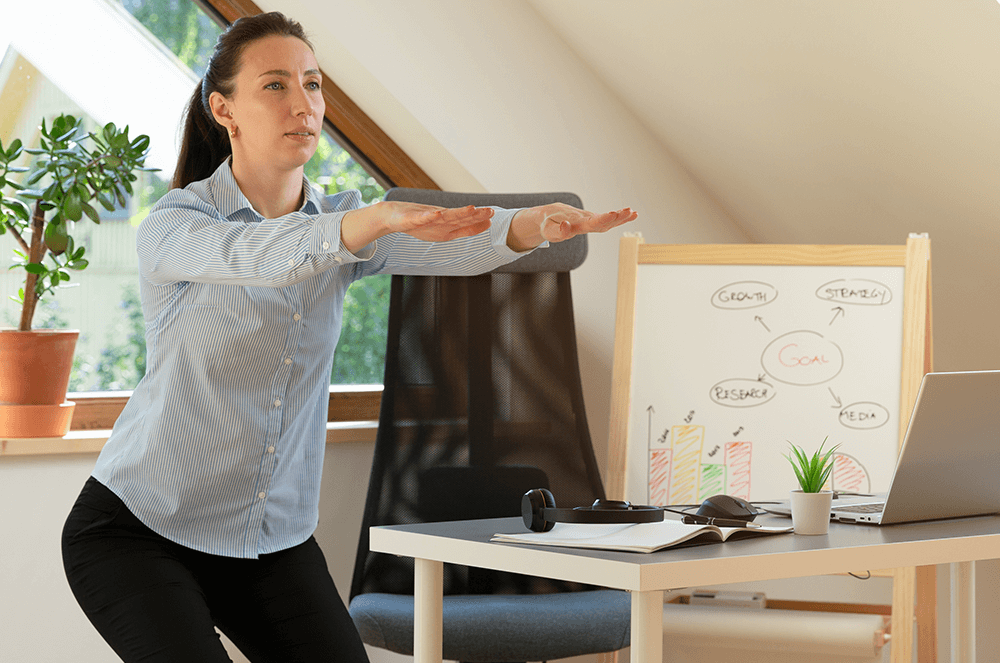Click play to hear an exclusive interview with Laura Vanderkam and the hosts of The Toastmasters Podcast.
Working from home was on the rise before March 2020. However, when the COVID-19 outbreak closed almost all non-essential offices, an even larger shift in the workplace happened overnight.
A recent survey by Global Workplace Analytics found that 88% of office workers are working from home at least one day a week during the pandemic, with 76% of them saying they want to continue to work from home in some form once the pandemic is over. The organization predicts that 25-30% of the global workforce will be working from home multiple days a week by the end of 2021.
I’ve been studying productivity for the past 12 years. I’ve written several time management and productivity books, and host two podcasts on the topic. My TED Talk, “How to Gain Control of Your Free Time,” has more than 10 million views. Lately, I’ve been delving into the topic of how people can remain productive, even with all the distractions, or quietness, of home.
Nothing is ideal in a crisis, but in general, people tend to like their home offices. Commutes waste time. Working from home allows people to control their environments and work how they work best.
Of course, working from home presents its own challenges too. If you’ll be doing it for the foreseeable future, or would like to work from home long term, here are a few new habits that can help you be more productive during working hours, and make some positive changes for your whole life too.
Think Task, Not Time.
In an office, a workday is often defined by a typical starting time and ending time. Absent a commute, this can be nebulous. How can you feel confident you’ve put in an honest day’s labor? The best approach is to start defining your days by tasks, rather than time. Set yourself challenging but doable goals for each day: three to five tends to be a good number. The goal is to make progress, but not be totally spent, so you can make progress again tomorrow. When you have finished your intentions for the day, then the day is done, whatever time it happens to be. This is a great way to manage remote workers too. Have your team members share their goals for the day or week, and then check in on their progress. This is more productive than counting hours spent in a chair.
Match the Right Work to the Right Time.
Match the Right Work to the Right Time. Working from home requires self-direction. Absent group norms, you need to figure out when to tackle various projects. A pro tip: Most people have more energy and discipline in the morning. So the first hour or two of the workday is a great time to tackle your toughest projects. Save the inbox clearing and low-key status meetings for afternoon, when most people find their energy levels dropping. If your work hours tend to feature a lot of back and forth with colleagues, consider starting an hour early to take advantage of uninterrupted time. You can always take a longer break or stop a little early to keep things in check. And if you’re a night owl? The good news is that remote workers tend to have more control of their schedules — so feel free to schedule your challenging work later in the day, when you’ll best be able to handle it.Set yourself challenging but doable goals for each day: three to five tends to be a good number.
Take Breaks.
No one can work without stopping. People think they can, but then they wind up working inefficiently or getting sucked into social media sites for far longer than they intend. Punctuate your day with a few well-chosen breaks, and you’ll get a lot more done. Most people need a small break in mid-morning, a break for lunch, and then a break in mid-afternoon. Think about what will boost your energy levels, and proactively plan these activities into your slumps.Reach Out.
Socializing is more automatic when you work in person, but it doesn’t have to be absent from work-from-home days. One idea: Rather than emailing back and forth with colleagues about logistical matters, pick up the phone and call. This is more efficient, and lets you hear people’s voices. Start virtual meetings with a few minutes of scheduled social chat. It’s going to happen anyway, and putting it on the agenda means it’s built into the model, so it doesn’t run on too long, and everyone expects it—that way nobody snarls about not having time for this. That can start any meeting on the wrong foot.
Move.
Long commutes are negatively correlated with physical activity. People who work from home have more time to exercise. The problem? They have less occasion to; the walk from your bed to your desk might be just a few steps! So be sure to build in a chance to move during the day. You could do some push-ups and sit-ups during a break, or take a call while walking around the block. Set a goal, like taking 2,500 steps during the workday, or doing 100 jumping jacks by quitting time.Punctuate your day with a few well-chosen breaks, and you'll get lot more done. Think about what will boost your energy levels, and proactively plan these activities into your slumps.
Over-communicate.
When you work in a home office, it’s harder for people to see what you’re doing. They can’t read your mind. So keep your boss updated on your task lists for each day (or week) and remind colleagues of anything you’ll need from them well ahead of time. If you’re stuck on something, no one can see you flailing. So you’ll need to speak up. Some organizations create time for collaboration and time for focus by setting core hours where everyone is available. For instance, you might be available by phone, email, and instant message only at certain hours of the day. Then you can do the rest of your work whenever works for you.Embrace Leftovers.
Meals eaten at home tend to be healthier than those eaten out. That means that work-from-home days can be an opportunity to establish healthy eating patterns. To do this efficiently, get in the habit of making more food at dinner than you need. Then you can eat these leftovers for lunch for the next day (or two). If your dinner included vegetables, now your lunch has vegetables too. Add a piece of fruit for a snack and you’re well on your way to getting enough produce—or at least further along than you’d be grabbing a burger and fries from a restaurant near your office.Make Your Workspace Your Happy Place.
Working from home gives you a chance to experiment and see what conditions make you most productive. So make sure you’re comfortable, with a good chair, a desk, and a door that closes. Put your desk near a window so you get some natural light. Curate what you see out that window—clear away any garbage or broken furniture, and maybe add a plant or something that will make you smile. And remember that anything behind you will be visible in video conferences, so this is a great opportunity to showcase your personal brand with art, books, flowers, or even a conversation piece (like a pet turtle—that will always give people something to ask about).
End Well.
Lots of people have starting rituals for work, but the truth is, you’re going to begin at some point regardless. Ending is trickier. If you can see your workspace from other parts of your house, it can be hard to relax, and people wind up half-working and half-surfing the web well into the night. To cut this off, try creating an end-of-day ritual. You can write tomorrow’s to-do list, write in a journal, or call a colleague to say goodbye. You can walk around the block, or run an errand. If you find this challenging, try creating some sort of commitment in your personal life that will force the issue. If you are running a virtual book club at 7 p.m., you’ll have to stop work a bit before that—and you’ll be more efficient on those days when you have a hard stop.
Did you enjoy reading these tips? Take this quiz to test your knowledge about your work from home habits.
Laura Vanderkam is the author of six books on productivity, including Off the Clock: Feel Less Busy While Getting More Done and The New Corner Office: How the Most Successful People Work From Home. For more information, visit www.lauravanderkam.com.
Related Articles

Personal Growth
Reframe Your Life in 5 Seconds

Personal Growth
Development On Demand

Personal Growth
Tips For Time Management

Club Experience



 Previous
Previous
 Productivity in Toastmasters
Productivity in Toastmasters
 Previous Article
Previous Article